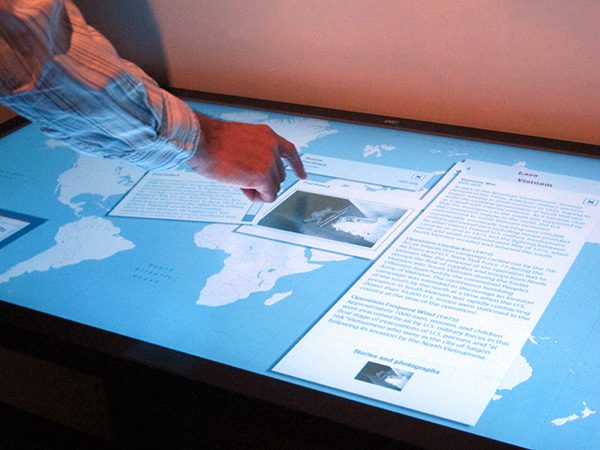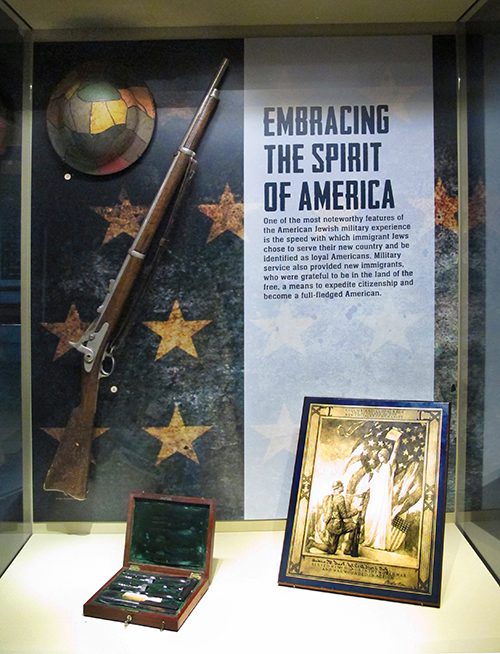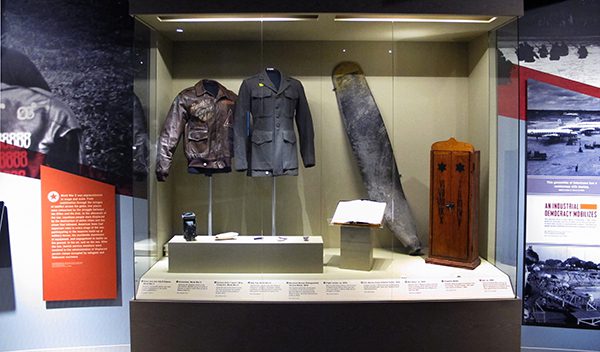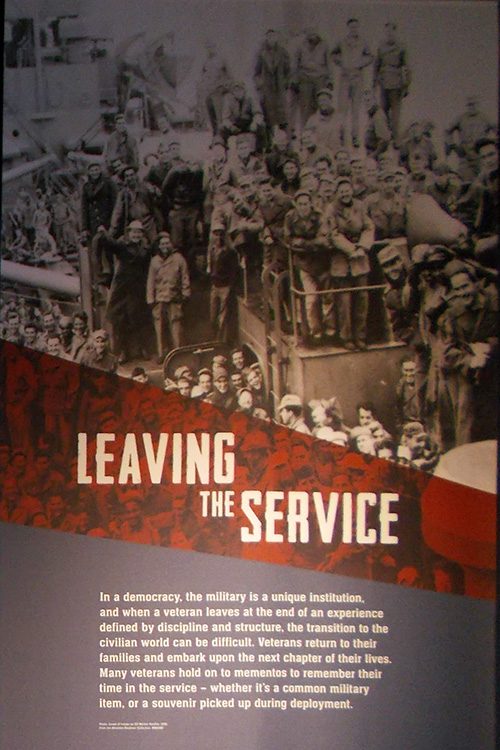NMAJMH’s Core Exhibit
“Americanism is a question of spirit, conviction, and purpose, not of creed or birthright…” –Theodore Roosevelt
Jews in the American Military uses this quote from Theodore Roosevelt, and more specifically the broad theme of Americanism, as a focal point for examining the role of Jews in the United States military from the colonial era to today.
Using President Roosevelt’s taxonomy of Spirit, Conviction, and Purpose, the exhibition addresses the following questions (and encourages visitors to consider their own answers to each, whether by reflecting on their own service or that of their relatives): Why do people serve in the American armed forces? When and in what contexts – did they serve? How did they serve?
Although the exhibition focuses on the service of Jewish men and women throughout the history of the United States, the subtext of the entire space is the universality of military service.
Answering the Call
The Answering the Call section features a video depicting the story of the Jewish American men and women who answered the call to enlist in the military during World War I and World War II. Visitors learn about the transition from civilian life to military camp through scenes of induction, marching, and other camp activities. A large display case features artifacts relating to military life, including a footlocker, cot, bedding roll.
This section also includes displays about early American Jews like Asser Levy, who fought for the right to bear arms in defense of his community in seventeenth-century New Amsterdam; Francis Salvador, who was the first Jew known to die for American independence; and Uriah P. Levy, who served in the US Navy during the War of 1812 and later rose to the rank of commodore despite facing anti-Semitism during his forty-year naval career.
Spirit
This section of the exhibit centers on Jewish military service in the Civil War through World War I. Many Jews emigrated from Eastern and Central Europe during this period, and one of the most noteworthy features of the American Jewish military experience is the speed with which immigrant Jews chose to serve their new country and be identified as loyal Americans.
The focal point of Spirit is a large-scale video projection, featuring notable moments in American Jewish military history from this period. The film also highlights the achievements of a few exceptional individuals including Colonel Marcus Spiegel, Abraham Krotoshinsky, and Medal of Honor recipient Benjamin Kaufman.
Artifacts are included from the conflicts of this period, including Civil War correspondence from Capt. David Rosenstein, Co. C, 1st Infantry Regiment of the Missouri State Militia (1864), a soldier’s notebook used by Mayer Dodek during the Spanish-American War (1899), and a helmet with multi-color camouflage pattern worn by Elijah Wisebram during World War I (1918).
Conviction
As Nazi Germany emerged as a hostile power in Europe, American Jews with strong convictions about liberty and democracy served their country in unprecedented numbers. The Jewish Welfare Board estimated that 550,000 Jews served in the armed forces of the United States between 1941 and 1945. Conviction tells the story of those American Jews who fought and sacrificed in every branch of service and every theater during World War II. From Rabbi Alexander Goode, who was one of the four chaplains who perished when the U.S.S. Dorchester sank, to Frances Slanger, who was the only nurse to die as the result of enemy action in the European Theater, Jews played an important role in the Allied victory.
Conviction features two multi-media elements. The first is a touchscreen interactive featuring images of World War II, from mobilization to homecoming. The second is an oral history listening station. Visitors can listen to firsthand accounts of Jewish service members who encountered the Holocaust and liberated survivors.
A large display case includes a propeller blade salvaged from Reuben Fier’s B-17 bomber that was shot down over France on January 1,1944, a diary kept by Louis T. Wigdortz while a prisoner of war at Stalag Luft III (1944-45), and an ark used by Chaplain Morris Gordon for services on the Burma Trail services during WWII (ca. 1943).
Purpose
Following the end of World War II, the United States led Western efforts to contain communism. Purpose tells the story of Jewish service during the Cold War through the present day. Both during and after the Cold War, the United States was a cornerstone of global stability, and American Jews served in large numbers as new threats to peace and freedom emerged.
A large display case features artifacts from the Korean and Vietnam Wars as well as Operations Iraqi and Enduring Freedom. These include a camouflage yarmulke (kippah) made of tent material and provided to Jewish U.S. marines for High Holy Days services in Da Nang in 1967, and the uniform of SPC Daniel Agami, who was killed by a roadside bomb in Iraq on June 21, 2007.
 Visitors can learn more about SPC Agami and the other Jewish servicemen and women who died while serving in Iraq and Afghanistan through our Fallen Heroes touchscreen interactive. Before leaving this section of the exhibition, visitors can also learn about Jewish service in the American military since 1945 through Service Around the World. In this multi-user interactive, visitors use a timeline to access a series of world maps showing the locations of American military operations. By tapping a location, visitors can call up stories of service members’ experiences through brief text and photographs.
Visitors can learn more about SPC Agami and the other Jewish servicemen and women who died while serving in Iraq and Afghanistan through our Fallen Heroes touchscreen interactive. Before leaving this section of the exhibition, visitors can also learn about Jewish service in the American military since 1945 through Service Around the World. In this multi-user interactive, visitors use a timeline to access a series of world maps showing the locations of American military operations. By tapping a location, visitors can call up stories of service members’ experiences through brief text and photographs.
Leaving the Service
The final section of the exhibition is Leaving the Service. In a democracy, the military is a unique institution, and when a veteran leaves at the end of an experience defined by discipline and structure, the transition to the civilian world can be difficult. Veterans return to their families and embark upon the next chapter of their lives.
Many veterans hold on to mementos to remember their time in the service – whether it is a common military item or a souvenir picked up during deployment. A group of display cases highlights these items, including a Spanish-American War commemorative poster and a coconut mailed from a soldier in Guam to his daughter in Virginia during World War II.
Leaving the Service also profiles a selection of distinguished American Jews who have served with honor. All have dedicated their lives in one way or another to the armed forces of the United States. Sidney Shachnow is a Holocaust survivor who immigrated to the United States as a young man and enlisted in the U.S. Army in 1955. His lengthy military career spanned the globe, taking him from Vietnam, where he served with the famed Green Berets, to West Germany, where he worked as a member of a clandestine army unit that penetrated the Iron Curtain to collect information about the Soviet Union and its allies. He eventually attained the rank of major general, retiring after 40 years of highly decorated service.
The final display shows the work of the Jewish War Veterans of the U.S.A. (JWV), America’s oldest continuously active veterans organization. Civil War veterans founded the organization in 1896 and since then, JWV has served as the “patriotic voice of American Jewry,” working to support veterans and combat bigotry. A video station in this section lets visitors learn more about JWV through two speeches by Past National Commander Robert Zweiman.



